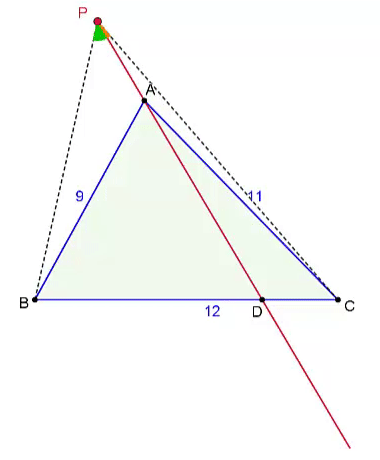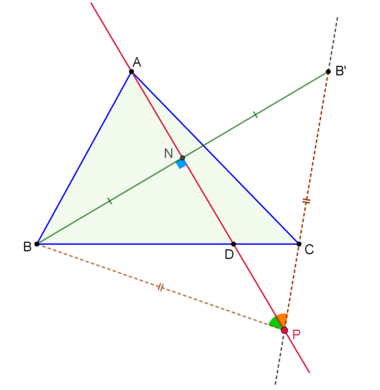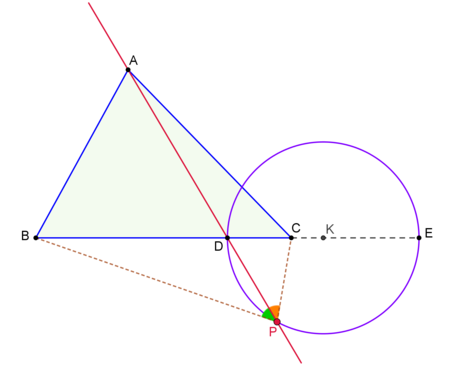First construct, then find the distances.
 A
B
C
is a triangle with
A
B
=
9
,
A
C
=
1
1
and
B
C
=
1
2
. Point
D
lies on side
B
C
, so that
B
D
=
3
D
C
. First, construct (in the Euclidean sense:
straightedge and compass
) a point
P
on line
A
D
, so, that
B
D
and
D
C
are subtended by equal angles from
P
. Then, find its distances from vertices
B
and
C
.
A
B
C
is a triangle with
A
B
=
9
,
A
C
=
1
1
and
B
C
=
1
2
. Point
D
lies on side
B
C
, so that
B
D
=
3
D
C
. First, construct (in the Euclidean sense:
straightedge and compass
) a point
P
on line
A
D
, so, that
B
D
and
D
C
are subtended by equal angles from
P
. Then, find its distances from vertices
B
and
C
.
If P B = m and P C = n , submit m + n .
The answer is 16.
This section requires Javascript.
You are seeing this because something didn't load right. We suggest you, (a) try
refreshing the page, (b) enabling javascript if it is disabled on your browser and,
finally, (c)
loading the
non-javascript version of this page
. We're sorry about the hassle.
4 solutions
Very nice work, on both, the calculation of lengths (Stewart's theorem is a useful tool) and the construction. Thank you for posting.
Log in to reply
Thank you for the kind comments/remark.
Log in to reply
Thank you for the problem, Thanos and lessons on Stewart's theorem, Sathvik. I did it the long way with cosine rules, but now I've learned a new shortcut.
Log in to reply
@Saya Suka – Yes, Stewart's theorem is a very helpful in many cases. Also, proof of Stewart's theorem is just cosine rule applied twice :)
@Saya Suka – I'm glad you found interesting ideas in this problem and its solution. Indeed, Stewart's theorem saves time.
You can find a way around Stewart's using Ptolemy's theorem :)
Log in to reply
What about the length of diagonal MP ?
Log in to reply
You only need the ratio M D : M B . (Which is easy to determine?)
Construction #1
Here is a quick construction:
 Step 1:
Reflect point
B
across line
A
D
and let the image be point
B
′
.
Step 1:
Reflect point
B
across line
A
D
and let the image be point
B
′
.
Step 2: Draw line B ′ C .
Then,
P
is the intersection of
B
′
C
and
A
D
.
Indeed,
△
B
B
′
P
is isosceles, with its height
P
N
lying on
A
D
. But this height is also the angle bisector of
∠
B
P
B
′
, hence,
∠
B
P
D
=
∠
C
P
D
.
Construction #2
By
Angle Bisector Theorem
, it holds that
P
C
P
B
=
D
C
D
B
=
3
Hence, point
P
lies on an
Apollonian circle
of segment
B
C
for this ratio.
 Step 1:
Construct the harmonic conjugate of
D
w.r.t.
B
and
C
, i.e. extend
B
C
to a point
E
, such that
B
D
=
D
E
. Indeed, if
B
D
=
D
E
, then
E
B
=
1
8
and
E
C
=
6
, thus
E
C
E
B
=
6
1
8
=
3
=
D
C
D
B
Step 2:
Construct a circle of diameter
D
E
(the Apollonian circle)
Step 1:
Construct the harmonic conjugate of
D
w.r.t.
B
and
C
, i.e. extend
B
C
to a point
E
, such that
B
D
=
D
E
. Indeed, if
B
D
=
D
E
, then
E
B
=
1
8
and
E
C
=
6
, thus
E
C
E
B
=
6
1
8
=
3
=
D
C
D
B
Step 2:
Construct a circle of diameter
D
E
(the Apollonian circle)
Then, P is the intersection of A D and this circle (different than D ).
Indeed, since P belongs to this particular Apollonian circle, it holds that P C P B = D C D B And, by (the converse of) the Angle bisector theorem, ∠ B P D = ∠ C P D .
Both constructions are extremely clever!
Place the diagram on a coordinate system so that B is at B ( 0 , 0 ) and C is at C ( 1 2 , 0 ) .
Since B D = 3 D C , and B D + D C = B C = 1 2 , B D = 9 and D C = 3 , which makes D at D ( 9 , 0 ) .
Let A have coordinates of ( A x , A y ) . Since A B = 9 and A C = 1 1 , by the distance formula ( A x − 0 ) 2 + ( A y − 0 ) 2 = 9 2 and ( A x − 1 2 ) 2 + ( A y − 0 ) 2 = 1 1 2 , and these two equations solve to A ( A x , A y ) = A ( 3 1 3 , 3 4 3 5 ) .
The line AD through A ( 3 1 3 , 3 4 3 5 ) and D ( 9 , 0 ) then has an equation of y = − 7 2 3 5 ( x − 9 ) .
Since P is on A D , let P have coordinates of P ( p , − 7 2 3 5 ( p − 9 ) ) .
Since ∠ B P D = ∠ C P D , by the angle bisector theorem, B P B D = P C D C , and since B D = 3 D C , then B P = 3 P C .
Since B P = 3 P C , then by the distance formula, ( p − 0 ) 2 + ( − 7 2 3 5 ( p − 9 ) − 0 ) 2 = 3 ( p − 1 2 ) 2 + ( − 7 2 3 5 ( p − 9 ) − 0 ) 2 , which solves to p = 3 3 4 , and makes B P = 1 2 and P C = 4 .
Therefore, B P + P C = 1 2 + 4 = 1 6 .
Nice job! Any alternative for the construction, different than the one @Sathvik Acharya proposed?
Log in to reply
Since B P = B C = 1 2 , P would be on the intersection of the line segment A D and an arc with a radius of B C centered at B .
Log in to reply
Yes, but the title says " First construct, then find the distances". What if you don't know that B P = 1 2 ?
Log in to reply
@Thanos Petropoulos – Sorry, I misread the question. I don't have an alternative construction other than Sathvik's, then.
Log in to reply
@David Vreken – I have posted one.
Log in to reply
@Thanos Petropoulos – @David Vreken - @Sathvik Acharya : I added one more construction.
Log in to reply
@Thanos Petropoulos – Wow, those are awesome! Thanks for sharing.
CDP is similar to BAP , which shows AD =2 DP . Put point E on BD and let BE =3, then AE =2 CP . Use Stewart's Theorem to solve AE =8, then CP =4, BP =3 CP =12
Nice, different approach, although very laconic. Thanks for posting.
Since B D = 3 D C and B D + D C = B C = 1 2 , we have, B D = 9 , C D = 3 .
Using Stewart's Theorem , in △ A B C , A D 2 ∴ A D = B D + C D A B 2 ⋅ C D + A C 2 ⋅ B D − B D ⋅ C D = 1 2 8 1 ⋅ 3 + 1 2 1 ⋅ 9 − 2 7 = 8 4 = 2 2 1
Consider point P on line A D such that ∠ B P D = ∠ C P D . Also, ∠ C D P = ∠ A D B = ∠ B A D ⟹ △ A P B ∼ △ D P C , C D A B 3 9 = ∴ P D = P C P B = D P A P n m = P D 2 2 1 + P D = 2 1 , m = 3 n Using Stewart's Theorem, in △ P B C , P D 2 2 1 5 7 6 ∴ n = B D + C D P B 2 ⋅ C D + P C 2 ⋅ B D − B D ⋅ C D = 1 2 3 m 2 + 9 n 2 − 2 7 = 3 ( 3 n ) 2 + 9 n 2 = 4 , m = 1 2 ⟹ m + n = 1 6
Construction: To locate point P on line A D ,
Draw the perpendicular bisector of B C and let it intersect A D at M .
Draw the circumcircle of △ M B C and the intersection point (other than M ) of line A D and the circle gives us the desired point P .
Since M lies on the perpendicular bisector of B C , M B = M C . Using the fact that equal chords subtend equal angles on the circle, we have, ∠ M P B = ∠ M P C ⟹ ∠ B P D = ∠ C P D .